Book Reviews
Book Reviews
MANAGEMENT OF DEFENSE ACQUISITION PROJECTS
Edited by Rene G Rendon and Keith F Snider
American Institute of Aeronautics and Astronautics, Reston, VA. xvi; 373pp. 2019. Illustrated. Distributed by Transatlantic Publishers Group, 97 Greenham Road London N10 1LN, UK. £73 [20% discount available to RAeS members on request; E mark. chaloner@tpgltd.co.uk ]. ISBN 978-1-62410-509-8.
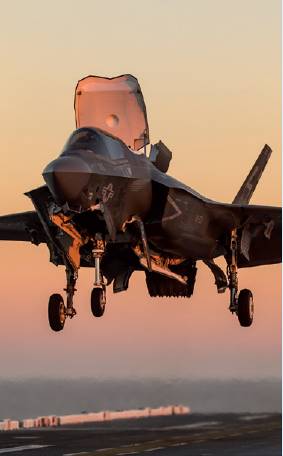 Lockheed Martin F-35B on board the USS America. Lockheed Martin.
Lockheed Martin F-35B on board the USS America. Lockheed Martin.
A valuable reference to current US defence acquisition processes, covering all of the various disciplines involved to varying extents. This should be of use to students and practitioners in the DoD and contractors to help understand the complex systems involved. It should also be useful foreign procurement agencies and contractors wishing to work with US defence contracting activities, although discussion about the effect of the International Traffic in Arms Regulations (ITAR) would have been helpful.
Each chapter has a learning objective, summary, references, study questions, with examples to illustrate issues. There is up-to-date referencing, as well as well-established references that are the basics of best practice.
How to effectively manage some of the latest challenging issues for defence acquisition is hardly touched upon. For example, digitalisation – where additive manufacturing (potentially design, development, manufacture, operation in weeks) is only briefly mentioned. While there are some attempts to look for new innovative and future developments in some of the chapters, it is mostly an explanation of what currently happens with traditional defence acquisition.
A valuable reference to current US defence acquisition processes, covering all of the various disciplines involved to varying extents
Some key points from the book are: the software acquisition management chapter is especially valuable with a good analysis of key issues, and emphasis that software maturity needs an understanding of both technology and management readiness levels. Test and evaluation (T&E) has undergone significant changes in recent years with the application of digital simulation but this only receives the briefest of mention, with no examples of the major improvements in cost-effectiveness of T&E using greater simulation of tests and trials. The risk management chapter does not mention how to understand causes of risk – for example the widely used Ishikawa diagram drawn from the quality management toolkit. Given ongoing procurement problems of poor performance, delays and overspend, it can be argued that there ought to be much more emphasis on effective risk management in procurement. The National Network for Manufacturing Innovation, established some years ago by the DoD, ought to have generated some improved processes to encourage innovative procurement as well as technology but these are not cited in the book.
Given the obvious experience of the authors, an exploration of why overspends and overruns continue to occur, with suggested improvements (indicated in some of the chapters) would be a valuable addition in each chapter of a third edition.
Lee R Balthazor
FRAeS
HOT SPOT OF INVENTION
Charles Stark Draper, MIT, and the Development of Inertial Guidance and Navigation
By Thomas Wildenberg
Naval Institute Press, 291 Wood Road, Annapolis, MD 21402, USA. 2019. xviii; 301pp. Illustrated. $48. ISBN 978-1-68247-469-3.
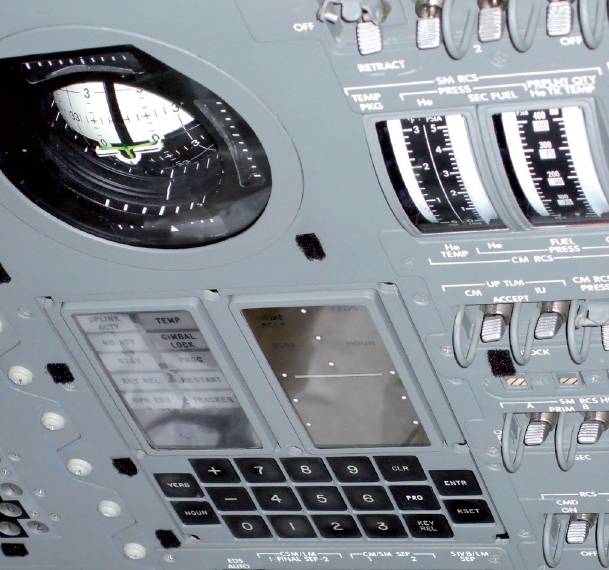 The display and keyboard (DSKY) interface of the Apollo Guidance Computer (AGC) mounted on the control panel of the Command Module, with the flight director attitude indicator (FDAI) above. The AGC was designed at the MIT Instrumentation Laboratory under Charles Stark Draper.Hot Spot of Invention covers three main areas, the story of Charles Stark Draper, the evolution of MIT and the development of inertial guidance and navigation. Contained within these three stories are two major themes – the development of one of the most hidden and possibly most esoteric technologies of the Cold War and a story of the 20th century equivalent of John Harrison’s chronometer and the measurement of longitude.
The display and keyboard (DSKY) interface of the Apollo Guidance Computer (AGC) mounted on the control panel of the Command Module, with the flight director attitude indicator (FDAI) above. The AGC was designed at the MIT Instrumentation Laboratory under Charles Stark Draper.Hot Spot of Invention covers three main areas, the story of Charles Stark Draper, the evolution of MIT and the development of inertial guidance and navigation. Contained within these three stories are two major themes – the development of one of the most hidden and possibly most esoteric technologies of the Cold War and a story of the 20th century equivalent of John Harrison’s chronometer and the measurement of longitude.
The biography of Charles Stark Draper (‘Doc’ Draper) is one of a consummate engineer whose life spanned a section of the industrial revolution starting with the development of high power internal combustion engines and ending with the modern age of electronics, computers and integrated circuits. As a young man with an intense interest in how anything worked, his early work covered the instrumentation of early internal combustion engines, especially those high-power versions used in aircraft. This work established him within the laboratories of MIT, an association which would continue with the evolution of MIT, together with an increase in ‘Doc’s’ academic qualifications. His understanding of the subtleties of the operation and function of instrumentation sensors led him into the world of gyroscopes and gun sights which ultimately led into the early development of inertial guidance and navigation.
Over the period of Draper’s association with MIT, the institution itself evolved from what was equivalent to a technical college into a world-renowned seat of learning and university. Draper was not swamped by this progression and he evolved to become a full professor and head of the aeronautical section of the university. This growth of MIT was driven by such luminaries as Karl Compton and Vannevar Bush and it brought out in Draper an inherent ability to inspire and teach students. Many of these students ended up in high positions in government and the armed forces and they in turn would contract Draper’s MIT laboratories to do further development work.
Einstein’s Principle of Equivalence provided a major stumbling block to the early development of inertial navigation and guidance. By establishing that it was not possible to distinguish between a gravitational field and an acceleration, it appeared impossible to obtain the necessary accuracy from an inertial sensing system. In addition, the drift requirements of contemporaneous gyroscopes were many orders of magnitude too large to provide the required accuracy. The celebrated physicist George Gamow was a powerful proponent of these points of view and very critical of any efforts to develop inertial navigation. If the Earth was completely spherical and of uniform density there would be no problem and it eventually transpired that irregularities in its shape and gravitational potential could be mapped and compensated for, to obtain more than adequate accuracy.
... the development of inertial navigation must rank alongside the solution of the longitude problem by John Harrison with his chronometers
Although GPS (Global Positioning System) is perhaps the most widely known modern navigation system, the development of inertial navigation must rank alongside the solution of the longitude problem by John Harrison with his chronometers. If your journey across a featureless ocean takes many days, there are ample opportunities to take solar or stellar observations to get local time to compare with chronometer (and hence home port) time. For fast-travelling vehicles like aircraft and missiles such journeys could take only a few hours with no opportunity to establish local time. Here precision inertial guidance provides position with no requirement for external sighting. This was obviously a significant factor in its development to provide navigation systems for intercontinental ballistic missiles during the Cold War.
This is a well-written and researched book and, while the text of 227 pages is primarily an historical narrative, the book contains a further 50 pages of notes and references. This means the book can be used as a basis and source for both technical research and historical investigation. It is also an enthralling read and I recommend it to you on all these points.
John R Pearce
CEng FIMechE MRAeS
TAKING FLIGHT
The Foundations of American Commercial Aviation, 1918-1938
By M Houston Johnson
Texas A&M University Press, College Station. 2019. x; 287pp. Illustrated. $45. ISBN 978-1-62349-721-7.
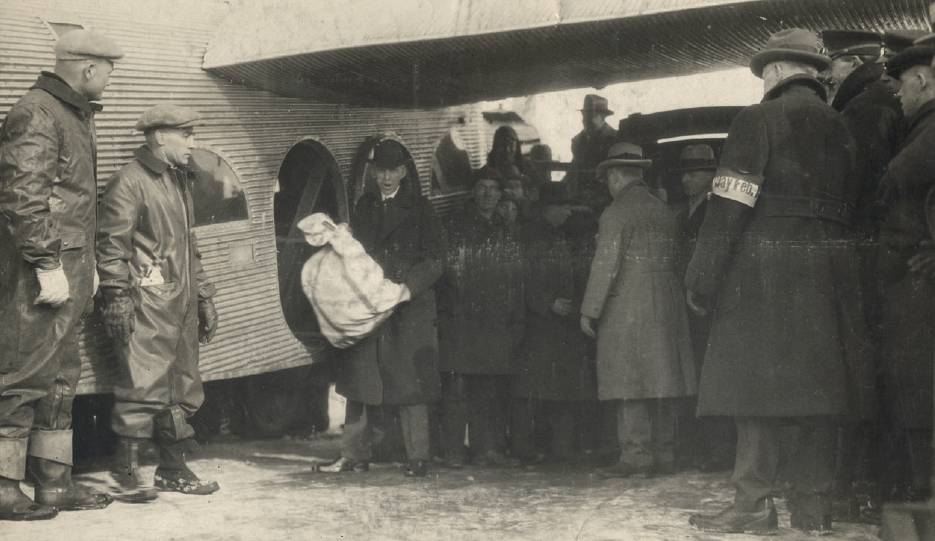 Henry Ford loads the first sack of air mail for Cleveland, Ohio, from Detroit at the Ford Airport, Dearborn, Michigan, 29 January 1924. RAeS (NAL).
Henry Ford loads the first sack of air mail for Cleveland, Ohio, from Detroit at the Ford Airport, Dearborn, Michigan, 29 January 1924. RAeS (NAL).
The history of commercial aviation in the United States between the wars has been recounted before and at many different levels, though few have covered it as elegantly and succinctly as the late Ron Davies in A History of the World’s Airlines (Oxford University Press 1964) (and which he later expanded upon in Airlines of the United States since 1914 [Putnam. 1983]), one of many sources cited by Professor Johnson. The subtitle of Taking Flight needs interpretation; the narrative really starts in 1921 when Herbert Hoover, future President but then Secretary of the US Commerce Department, began asking around for guidance and clarification of the government’s future role in the advancement of American aeronautics.
Hoover’s conclusion was that industry leaders were looking to the Commerce Department to exert leadership in defining a programme of development that would establish a sound basis for commercial growth. That seems a million air-miles away from Winston Churchill’s robust proposition in 1920: ‘Civil aviation must fly by itself; the government cannot possibly hold it up in the air’.
Hoover approached the issue differently, relying on what the author describes as a policy of associationalism: not a word I had ever come across before. The author defines it as ‘voluntary co-operation between government and business’, or more vaguely, ‘liberal corporatism’. It did mean that the US Government involved itself in the process of regulating air transport at a much earlier stage than in Great Britain, a reflection of the more legalistic approach common in America. One consideration was the need for Federal action to forestall state laws; better to have a common standard than to allow each state to develop its own legal requirements. As important was the role of the US Post Office in starting and expanding early air mail operations. The 1925 Contract Airmail Act, amended in 1926 and again in 1930, guaranteed air mail carriers would receive revenues from postal receipts rather than from general tax revenues, which led to an informal subsidisation of the industry.
The book is a comprehensive account of the formulation of Federal policy during the interwar era; the author suggests that the subtitle might have been ‘an investigation of interwar aviation policy’. The impact of the 1926 amendment was substantial and under the auspices of the Commerce Department created a whole administrative structure which included the Aeronautics Branch and the Division of Air Regulation (aircraft registration, airworthiness, licensing of pilots and air traffic rules). Curiously the organisation which framed policy and the subsequent structure of the airline industry, recognisable down to the present day, was the US Post Office, an executive department quite independent of the Commerce Department. Much of this was due to the appointment in 1929 of a new Postmaster General – Walter Brown – by the recently elected President, Hoover, a Republican. Brown, who possessed what the author calls ‘an accomplished political resume’ was left to his own devices, even though he had no history of engagement with aeronautics. But he clearly had strong views about the desirability of corporate size and strength and was able to use Post Office airmail payments to encourage the development of passenger services by persuading airlines to consolidate into larger units. He then gave them preference in the award of lucrative contracts for the airmail routes. In a very short time he had managed to reduce the number of players to just three groups controlling the four major airlines which received 90% of airmail revenues: American, Eastern, United and Transcontinental and Western, the latter more familiar in its later guise as TWA.
The book is a comprehensive account of the formulation of Federal policy during the interwar era
Things began to go wrong for Postmaster Brown after the election of Franklin D Roosevelt in 1932. Roosevelt, a Democrat, appointed a new Postmaster General, after which people began asking questions about some of Brown’s processes, especially the smaller airlines which had been left out of the magic circle; there was much talk of the ‘Spoils Conferences’ in 1930. In a somewhat hasty move, Roosevelt cancelled all the commercial mail contracts early in 1934, enlisting the Army Air Corps to carry the mails. That was an idea that didn’t fly; military pilots had little experience of operating in bad weather conditions, their aircraft were not suitable and over the next few weeks, there were many crashes and 12 pilots were killed. The military flights were stopped and the new Postmaster General hastily put together a scheme for airmail contracts which looked very similar to the old one. The main beneficiaries were of course still the same big four airlines but with some slight name changes to distance them from participants in the ‘Spoils Conferences’. American Airways changed its name to American Air Lines, for example.
Professor Johnson’s thesis is that for all the noise and smoke, there was little difference between the policies of Hoover and Roosevelt: the latter ‘maintained federal responsibility for subsidising airlines through airmail contracts, a core aspect of Hoover and Brown’s programme. Modifications represented changes of degree, not kind.’ Roosevelt went on to create the independent Civil Aeronautics Authority in 1938, putting to an end to any possible turf wars between the US Post Office and the Commerce Department. In an interesting parallel development, the British Government had just established its first Air Transport Licensing Authority and, belatedly, had begun using airmail contracts to help subsidise Imperial Airways and the other independents. A little told aspect of the Roosevelt administration’s aviation policy is described in the final chapters, namely the deployment of the considerable resources of the ‘New Deal’ Works Progress Administration to developing and building airports; just under one thousand airfields benefitted.
Taking Flight approaches American pre-war aviation history along a different flight path. It is densely written and well researched, with a comprehensive bibliography and 24 black-and-white photographs. However, there are no details of the airmail routes awarded, nor any maps. The book does not pretend to tell the whole story, just its legislative and policy aspects and their domestic impact. Airlines and the aircraft they used barely get a mention, Pan American and the award of Foreign Air Mail Routes are ignored. However, there are many other sources that readers can go to if they want to learn more about the thrills and spills of early American commercial aviation.
Guy Halford-MacLeod
FRAeS
CHASTISE
The Dambusters Story 1943
By Max Hastings
William Collins, HarperCollins Publishers, 1 London Bridge Street, London SE1 9GF, UK. 2019. xxviii; 388pp. Illustrated. £25. ISBN 978-0-00-828052-9.
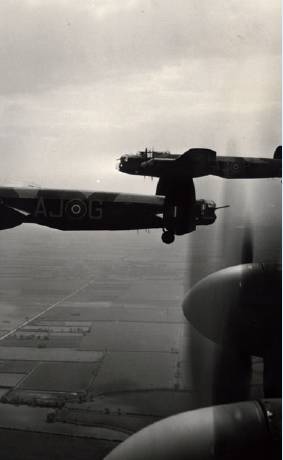 A scene from the Associated British film The Dam Busters. Lancasters on their way to bomb their target. RAeS (NAL).Like many of my generation with an interest in aviation and the history of WW2 I was captivated by this amazing feat of 617 Squadron RAF. There have been numerous books about the Dambusters, most of which I have read, so another might seem superfluous. Not so. This book is possibly the definitive publication on the ‘Dambusters’. It combines fascinating technical details of the equipment, preparation and execution of the operation with insights into the people involved in the raid and those affected by it – on both sides.
A scene from the Associated British film The Dam Busters. Lancasters on their way to bomb their target. RAeS (NAL).Like many of my generation with an interest in aviation and the history of WW2 I was captivated by this amazing feat of 617 Squadron RAF. There have been numerous books about the Dambusters, most of which I have read, so another might seem superfluous. Not so. This book is possibly the definitive publication on the ‘Dambusters’. It combines fascinating technical details of the equipment, preparation and execution of the operation with insights into the people involved in the raid and those affected by it – on both sides.
With the benefit of 76 years of hindsight the author has taken great care to write a balanced and objective account of the background and lead up to the raid, the raid itself and subsequent events. The author describes, warts and all, the primary characters involved in the operation, their human flaws, strengths and weaknesses and, where appropriate, paying due respect to their resourcefulness, courage and bravery in wartime. It excoriates some of the myths surrounding the operation and exposes some fatal shortcomings in the operational plans. The author addresses head on the conflict within the British government about the moral issues surrounding Sir Arthur Harris’ conduct of the bombing offensive and his initial dismissive attitude towards operation ‘Chastise’.
This book is possibly the definitive publication on the ‘Dambusters’
This book is extensively researched, including calling on the author’s primary research for his 1979 book Bomber Command (Michael Joseph Limited) when he interviewed some of those directly involved in the raid including: Air Chief Marshal Sir Arthur Harris, Air Chief Marshal Sir Ralph Cochrane, Sir Barnes Wallis and Air Vice Marshal Sir Harold ‘Micky’ Martin. It also references in some depth and detail numerous articles and papers about the raid and its aftermath. The supporting appendices, notes, references, bibliography and index take up the last 56 pages of the book.
The author’s honest writing style makes this a compelling and easy to read book. The photographs and illustrations are superb, some may be familiar but many I suspect are published for the first time.
This book is not revisionist and does not seek to diminish the raid or its protagonists and acknowledges that decisions were made under the pressures of war that with the benefit of hindsight may in later years have been made differently.
Cameron Macphee
FRAeS
NATIONAL AEROSPACE LIBRARY
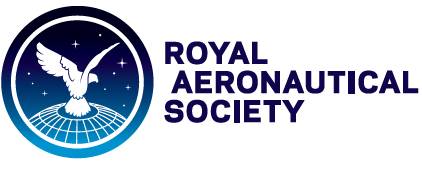 The National Aerospace Library is closed but our online services remain available so you can continue to browse the catalogue and download e-books as well as contact our expert Librarians for advice and enquiries.
The National Aerospace Library is closed but our online services remain available so you can continue to browse the catalogue and download e-books as well as contact our expert Librarians for advice and enquiries.
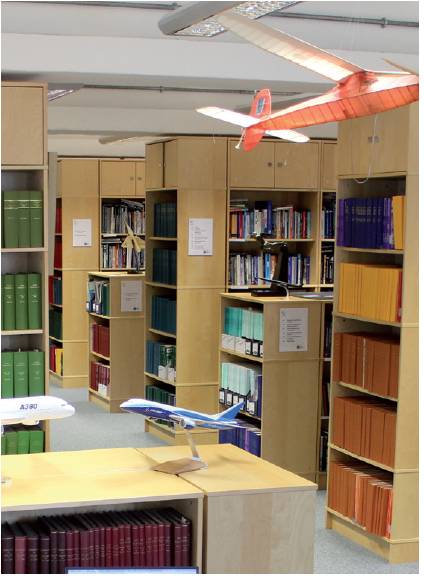
E nal@aerosociety.com
NAL www.aerosociety.com/nal
Catalogue www.aerosociety.com/catalogue
Film Archive www.aerosociety.com/movies
e-books www.aerosociety.com/ebooks

 Lockheed Martin F-35B on board the USS America. Lockheed Martin.
Lockheed Martin F-35B on board the USS America. Lockheed Martin.




